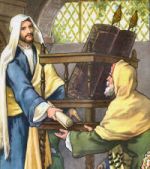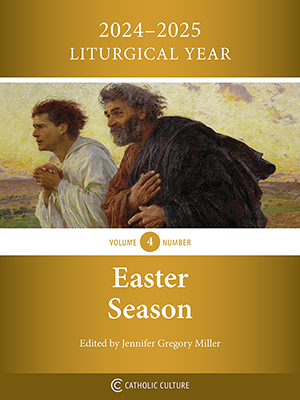Vatican newspaper continues lionization of Teilhard de Chardin with 5-article tribute
April 11, 2025
L’Osservatore Romano published a two-page, five-article tribute in its April 10 edition to Father Pierre Teilhard de Chardin (1881-1955), the French Jesuit philosopher and paleontologist whose support for eugenics continued even after the Holocaust.
Under the red-colored banner “Il 10 aprile 1955 Pierre Teilhard de Chardin moriva a New York” [On April 10, 1955, Pierre Teilhard de Chardin died in New York.], the Vatican newspaper published five articles:
- “Dimensione del pensiero“ [Dimension of thought], subtitled “Logos, matter, and the trajectory of evolution,” by Sister Ilia Delio, OSF, professor of theology at Villanova University and founder of the Center for Christogenesis, which promotes Father Teilhard’s thought
- “Scienziato visionario“ [Visionary scientist], an interview with filmmaker Frank Frost
- “Un paleontologo e una allevatrice di pavoni“ [A paleontologist and a peacock breeder], an article by Teilhard biographer Mercè Prats on Father Teilhard and American author Flannery O’Connor
- “Da una visione statica a una visione dinamica“ [From a static vision to a dynamic vision], by Abbot Stefano Visintin, OSB
- “Il domani promesso“ [The promised tomorrow], an article by staff journalist Roberto Cetera on a new book about Teilhard, edited by Paolo Trianni, a theology professor at the Pontifical Gregorian University
The articles are the latest in a series of recent Vatican tributes that have lionized the French Jesuit, who was the subject of a posthumous 1962 Holy Office monitum (warning) against his writings:
- In a March 3 message to the Pontifical Academy of Life, Pope Francis praised Father Teilhard for “his attempt—certainly partial and unfinished, but daring and inspiring—to enter seriously into dialogue with the sciences.”
- In its March 27 edition, the Vatican newspaper published a two-page, six-article tribute to Father Teilhard, with one headline describing him as “a Moses of the 20th century.”
- Between March 27 and April 7, Libreria Editrice Vaticana, the Vatican publishing house, posted 25 tweets related to its newly published biography of Father Teilhard. The biography, written by Mercè Prats, includes a preface by Cardinal José Tolentino de Mendonça, the prefect of the Dicastery for Culture and Education. The prelate wrote that “a particularly significant aspect of Teilhard’s thought, which Prats explores with great sensitivity, is his profound optimism” and that “another significant contribution of Teilhard is his reflection on love as a cosmic force.”
- Between March 27 and April 9, Father Antonio Spadaro, SJ, undersecretary of the Vatican’s Dicastery for Culture and Education, highlighted the legacy of Father Teilhard in ten tweets. “Since he was a child he felt called to reach out towards the freshness of reality, to seek it, to find it everywhere,” Father Spadaro wrote in one tweet. “Teilhard has always known that at the bottom of things there is an incandescence that has pushed him to love matter for spiritual reasons.”
- In its April 9 edition, the Vatican newspaper published a one-page, two-article tribute to Father Teilhard. In one article, Father Spadaro explored the relationship between Father Teilhard and the magisterium of Pope Francis, writing that “Pope Francis, in remembering his name, brings him back into that great Catholic tradition that knows how to welcome prophecy, recognize boldness and preserve spiritual intelligence. A Church that prays on the altar of the world cannot but look with gratitude to this Jesuit of the frontier, in whom love for Christ has become fire in the heart of matter.”
April 10 articles
The five articles in the Vatican newspaper’s April 10 edition made no reference to Father Teilhard’s views on race and eugenics, which have come under increased scholarly scrutiny over the past decade.
Father Teilhard’s “profound insights, born of a curious mind and an Ignatian spirit, allowed him to chart a path toward a new religious awareness compatible with an evolving world,” Sister Ilio wrote in her article. “In essence, Teilhard discovered a new and vital divine presence: not a God who merely adorned the world with power, but a God integral to the becoming of the world.”
She added:
Teilhard’s theological position is in line with emerging theism, yet he opts for a new kind of theology, what he calls a “second form of pantheism” influenced by Omega, which is neither supernatural nor natural, but described by the term “centric,” where “the cosmic, the human and the Christic meet.” Teilhard’s personalist universe resembles a vast trans-human body in the process of formation.
“I have always admired the figure of Teilhard, both from a spiritual point of view and as a scientist,” filmmaker Frank Frost said in his interview. “I believe he represented a central figure in the thought of the last century, but whose fame did not go beyond the confines of insiders.” Frost, who graduated from college in 1964, added that “Teilhard was very important for our generation: we would like him to be known through this film also by a younger audience.”
In her article on Father Teilhard and Flannery O’Connor, Prats discussed a 1952 meeting between the two at a home in Connecticut. (Father Teilhard referred to the meeting in one of his letters, though O’Connor never mentioned it.) Prats, who said that O’Connor began to read Teilhard in 1959, also cited three references O’Connor made to Teilhard in her volumes of letters.
“Teilhard de Chardin was among the first to highlight that the transition from a static to a dynamic vision of the world also has consequences on the way of understanding God’s action in the world and his omnipotence,” Abbot Visintin wrote in his article. “In a world on the path to perfection, God’s action could not be conceived only as the metaphysical and static maintenance in being, nor even as the occasional miraculous action that suspended the laws of nature that God himself had established.”
“The fact remains that the perspectives opened by the French Jesuit, after initial hesitation, have also been welcomed and adopted by official theology,” Abbot Visintin added, citing Pope Francis’s encyclical Laudato si’.”
In the final article on Father Teilhard in the Vatican newspaper’s April 10 edition, Roberto Cetera spoke of the “permanent relevance of his [Teilhard’s] intuitions.”
“There is no doubt that Teilhard anticipated in time many of the themes” of postconciliar theology, wrote Cetera, “with a courage that would cost him the sacrifice of misunderstanding, today totally overcome, both for the implicit overcoming of the monitum he incurred, and for the recurring citations of his thought made by Pope Francis.”
Cetera added:
The Church owes a debt to Teilhard: the ‘metabolization’ of evolutionism in the Catholic doctrinal corpus still cannot be said to be complete today, and in this sense the relevance of the Jesuit thinker and scientist still has much to say. Especially in a context in which the dialogue between science and faith seems to have supplanted the traditional one between faith and philosophy, on which centuries of systematic theology and apologetics have been cemented.
Then the centrality of the Eucharist, connected and extended to the concept of the cosmic Christ. And again: the reflection on original sin, which—unlike the criticisms of his detractors—he did not deny at all, but proposed on a different level, that of the natural limitation and vulnerability of the human, which always remains perfectible. And also many themes that are very current today, such as the criticism of clericalism, the role of women in the Church, and the relationship with other religions seen in an inclusive key, albeit in the perspective of fulfillment.
“His vision of the world is marked by a continuous progression towards a final Omega, that is, a progressive Christogenesis, reachable through the tension towards the unification of the human and the common adherence to the law of love,” Cetera concluded. “Teilhard’s thought was not anticipatory and innovative only in his time, but maintains a vital and prophetic charge that is more than ever needed by the Church today.”
For all current news, visit our News home page.
All comments are moderated. To lighten our editing burden, only current donors are allowed to Sound Off. If you are a current donor, log in to see the comment form; otherwise please support our work, and Sound Off!
-
Posted by: dover beachcomber -
Apr. 11, 2025 8:19 PM ET USA
Of Teilhard's heresies Cetera writes that they are "more than ever needed by the Church today." Like a drowning man needs a millstone. Rome seems not to be content with manufacturing new millstones, but must also go out to the back garden to dig up old ones. What's next? Strange new respect for the "intuitions" of Arius?







